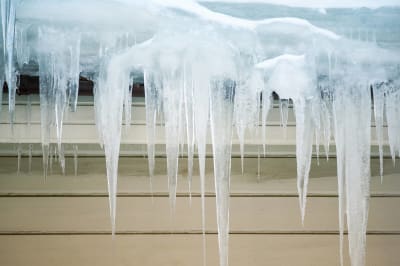Ice and Water Shields: What You Need to Know

Your roof is your shelter, so it needs to be able to protect your home against wind-driven rain and ice dams.
How do you ensure your roof will do that?
With an ice and water shield.
Keep reading to learn what this shield is, how it works, and why you need it.
What Is an Ice and Water Shield?
Think of it as a big piece of rubber tape. Three foot wide, with an adhesive back, it goes all along the edge of your roof, in any valleys and around any of the penetrations, around anything coming through the roof, and along any wall that hits the roof.
These areas are all vulnerable to water damage when water or ice accumulate on your roof. The ice and water shield acts as a self-healing membrane, protecting your roof from damage.
How Does It Work?
An ice and water shield is a fully-adhered roof underlayment, which in layman’s terms means it sticks to your roof. It’s not going to blow away in a strong wind or shift from the pressure of snow and ice.
It’s also self-healing. That means, when your roofer nails the shingles on top of it, the membrane seals around each nail.
These two qualities work together to give you superior leak protection against harsh weather conditions.
Why Do You Need It?
When water gets under your shingles, if you don’t have a moisture barrier, you’re going to develop a leak. Here are a few ways that can happen.
Ice dam: In winter, accumulated snow can begin to melt on a warm, sunny day. When it does, it flows down your roof, toward the edge. But if temperatures drop before the snow has completely melted, the runoff will refreeze into ice.
When temperatures warm up again, this layer of ice can take longer to melt than the snow behind it. Instead of melting, it becomes a dam, holding back newly melted water, pushing it back up the slope of your roof and underneath your shingles.
Severe storms: Storm season can often bring tornadoes and hurricanes. In severe weather, strong winds may lift shingles, leaving an unprotected area where rain can easily seep in, or push rainwater beneath shingles, causing a leak.
In both of these situations, a waterproof barrier that adheres to the house (and therefore can’t be lifted or moved by ice or heavy winds) will prevent water from leaking into your home. Instead, it will guide water downward, into the gutter.
Should You Cover Your Entire Roof with Ice and Water Shields?
If the shield waterproofs your roof, it only makes sense to cover your entire roof, right?
Not necessarily.
Covering your entire roof may be overkill. In most cases, if you place the ice and water shield in vulnerable areas — near eaves, valleys, low pitches, and along chimneys, for example — you’ll be able to prevent most leaks without spending more money than necessary.
More importantly, if you cover your entire roof with the ice and water shield, you’ll create a vapor barrier that will keep your deck from being able to breathe. That will cause condensation, which can, in turn, create water damage.
That said, you can cover your entire roof with an ice and water shield, and it could help prevent leaks if you live in an area with extreme winds. But if you do, make sure you also add a ventilation system to your attic to prevent condensation.
More Information…
You may also see this product referred to as an ice and water shelf. It works with asphalt, fiberglass, and felt shingles, as well as tile and metal roofs.
Bottom line, an ice and water shield is an important part of your new roof. Talk with your roofer about the products they’ll use on your roof. Make sure you have the leak protection you need to keep your home safe.